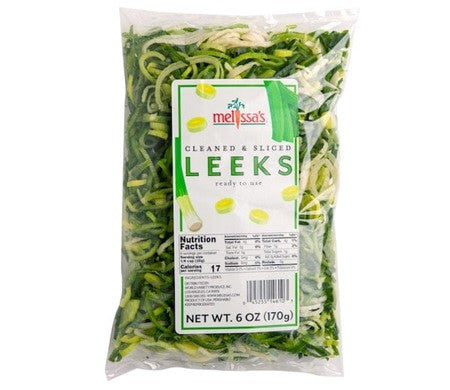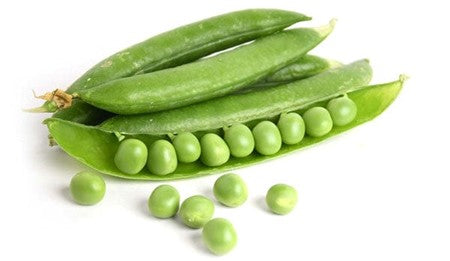What to Eat This Spring

Rhubarb
Rhubarb is actually a vegetable, but it is used like a fruit. Rhubarb is a plant with edible stalks (similar to celery stalks) with inedible leaves. Generally, the tart stalks are used in desserts like pies with sugar. The most common use is in strawberry-rhubarb pie.
There are two kinds of rhubarb: hot-house and field-grown. Hot-house rhubarb is available in spring. It is brighter red, sweeter and more tender than the field-grown rhubarb. Field-grown rhubarb is usually available from April to June.
Rhubarb has trace amounts of fat and is a source of vitamin C. It is low-calorie, with about 25 calories per ounce. Rhubarb is firm and glossy when fresh.

Cleaned & Sliced Leeks
Melissa’s Cleaned and Sliced Leeks make meal prep easy by cutting the edible part of the vegetable into carefully sliced and ready-to-use pieces. This new pack is simple and convenient to use in your favorite recipes. Leeks are related to both onions and garlic, but they are milder in flavor and fragrance. Used primarily as a soup green, leeks can also be used in salads or just cooked with a combination of vegetables for a side dish.
Leeks are low-calorie and full of flavor. They are high in vitamin A and a good source of vitamin C; a great addition to salads or any recipe to which you would add chives or shallots.

Steamed Baby Red Beets
Melissa's Baby Red Beets are so convenient and easy to use. No more mess from boiling and peeling fresh beets. These no-hassle beets are vacuum sealed for extended shelf-life (a good three months!). Just slice or dice and add to your favorite recipe. They can be served hot or cold.
Melissa's Baby Red Beets are approximately 40 calories each and contain no fat, sodium or cholesterol. Beets are also a source of fiber and are rich in potassium.

Fiddlehead Ferns
This “first of spring” vegetable is unique and delicious. Only available for the first few weeks of spring, they are the telltale sign that spring has arrived. Generally harvested when still curled, these young ferns come from the west coast. They are referred to as “fiddlehead” because their curled shape looks similar to the top of a fiddle.
Fiddleheads can be sautéed or steamed and are very perishable once harvested, so use immediately for best results.

Brussels Sprouts
These mini-cabbage-looking vegetables are composed of tightly wrapped leaves filled with vitamins and flavor. One of the latest trends for chefs, shaving Brussels sprouts for salads and side dishes, is becoming more and more popular. Restaurants and home kitchens are adding delicious nutrition to menus and meals everywhere with this flavor-packed vegetable.
Melissa’s also offers a ready-to-eat version of Brussels sprouts in a vacuum-sealed package. Convenient for last-minute side dishes or meals.

Fresh English Peas
Dive into the taste of spring with Melissa's English Peas! These little gems, also known as garden peas or green peas are vibrant green, perfectly round pods, each bursting with sweet, tender peas waiting to be enjoyed. Unlike their close cousin, the snow pea, English peas must be shelled before eating as the pod is not edible.
Melissa's English Peas don't need much to shine. A quick steam with a touch of butter and your favorite seasonings unlocks their natural sweetness, making them a light and refreshing side dish. But their versatility doesn't stop there! Toss them chilled into a vibrant salad for a burst of color and flavor— their delicate taste complements meat dishes and pairs beautifully with potatoes, making them a welcome addition to any meal.

Fresh Fava Beans
Fava beans, originally from Egypt, grow in plump green pods. When the beans are very young and tender, they may be eaten whole. However, after removing them from the pod, the fava beans are usually peeled to avoid any bitterness occasionally caused by the skin. The beans themselves are green and have an earthy flavor. Fava beans are a wonderful addition to any meal. Serve as a hot or cold appetizer, as a side dish sautéed in butter, or in soups.
For a quick meal solution, our Peeled & Steamed Fava Beans come in handy.

Chile Peppers
There are several varieties of fresh chile peppers: yellow (or caribe), pasilla (or poblano), Fresno-red and green, habanero-assorted colors, jalapeno, Anaheim-red and green, and serrano, to name a few. Chile peppers get their heat from ‘capsaicin,’ an oil that can burn your eyes and mouth. The hottest of these mentioned is the habanero chile, which is much higher on the heat scale than the others—generally, the smaller the chile, the hotter the bite. Also, when preparing chiles, if you remove the seeds and ribs, the chile will be milder. We also suggest that you wear gloves and use caution not to touch your eyes.
A trending pepper right now is the shishito pepper. These peppers are approximately 3 to 5 inches long. They are used in both Asian and Latin cuisine. They have thin green skin and a thick-walled texture. Most shishitos are mild, but occasionally, you may get a spicy one. Shishito peppers are delicious added to stir-fries or quickly sautéed and eaten as a side dish.
Chile peppers add a delightful flavor to any dish. Try them in eggs, soups, stir-fries, sauces and even bread. They are very versatile, and you can use more or less, according to your liking. Chiles should be refrigerated and used immediately for the best flavor. They are low-calorie and are a great substitute for salty seasonings.

Ginger
Ginger root is one of the most popular “spices” used for flavoring foods and giving them some extra zing. It is most commonly found in Asian and Indian cooking, but it is finding its way into more and more recipes every day because of its pungent aroma and tangy flavor. Ginger is a root that looks like branches growing, and it is referred to as a “hand” of ginger. It is usually grated or thinly sliced to be used in stir-fries, dessert dishes, soups, casseroles and many other foods.
Ginger root adds a robust flavor to anything it is used in. It should be stored in the refrigerator, tightly wrapped in plastic and used in a week or so. It can also be frozen for up to two months.

Baby Dutch Yellow® Potatoes
Grown year-round in nutrient-rich volcanic soils where the days are warm and the nights are cool, Melissa’s Baby Dutch Yellow® Potatoes are produced under ideal conditions to create an irresistibly buttery potato. Our Baby Dutch Yellow® has a distinct, yellow flesh with a subtle flavor and a creamy texture. These are some of the best-tasting potatoes on the market today. They are naturally sweet and taste like they are already buttered. Dutch Yellow® Potatoes are an excellent source of fiber and potassium and are low in calories. They are great when baked, roasted, mashed or sautéed. They are also delicious in potato salad.

Jicama
Jicama is a very popular vegetable in today’s produce department. Sometimes called a ‘yam bean,’ jicama looks like a turnip, but the taste is similar to a potato or water chestnut. It is a very versatile vegetable for eating raw in salads or with dips, boiling and mashing like a regular potato. Jicama is also a great substitute for water chestnuts, with the same juicy, crunchy flesh that stays firm when slightly cooked.
Jicama must be peeled before using and should be stored like potatoes in a cool, dry place. It should last several weeks when stored properly.

Tomatillos
Tomatillos are sometimes referred to as Mexican husk tomatoes. They are thought to be native to Mexico, but no one is certain. Tomatillos are grown in California and a few other areas, along with Mexico. They are very popular for making green sauce or salsa. Tomatillos are actually a fruit, but like a regular tomato, they are used like a vegetable. The best way to store tomatillos is with the husk on in the refrigerator. They should keep for at least one week. Tomatillos are most often used in fresh salsa.

